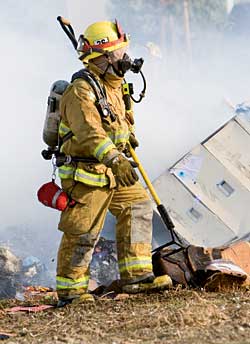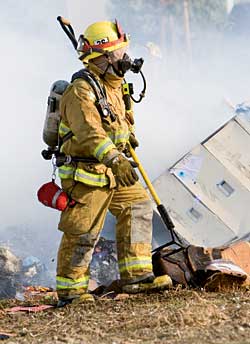
Complying with OSHA's Fire Safety Standards
Knowing what OSHA is concerned with and cites frequently can help you keep your fire hazards to a minimum.
- By Dr. Shawn Adams, C.P.C.U., A.R.M., PHR, CHCM
- Apr 04, 2007
 ONE of the most basic tasks of a safety professional is complying with OSHA requirements in regard to fire safety. OSHA requires a company to comply in a number of different fire safety areas. While these standards may look daunting, a basic understanding of how these standards are developed and set up can be helpful in ensuring your company is ready for OSHA scrutiny in this area.
ONE of the most basic tasks of a safety professional is complying with OSHA requirements in regard to fire safety. OSHA requires a company to comply in a number of different fire safety areas. While these standards may look daunting, a basic understanding of how these standards are developed and set up can be helpful in ensuring your company is ready for OSHA scrutiny in this area.
One of the first aspects of OSHA fire compliance to understand is that OSHA heavily relies on third parties in order to develop binding standards. For example, two organizations vital to OSHA's fire standards are the National Fire Protection Association (NFPA) and the International Code Council (ICC). It is important to understand that OSHA relies on their standards since the standards are used for other purposes, such as obtaining property coverage, complying with local codes, and simply providing a safe workplace under Section 5(a)(1), the General Duty Clause. For example, NFPA 30, which deals with flammable liquids, is the basis for OSHA's standards on flammable liquids safety. NFPA 101, the Life Safety Code, is not only incorporated into OSHA requirements, but also stands as a benchmark for fire egress for the commercial insurance industry. These standards are intertwined and overlapping.
OSHA General Industry, Construction Standards
OSHA standards addressing fire safety can be broken down into industries. Those applying to lesser-known industries include 29 CFR 1915 (Shipyard Employment), 29 CFR 1917 (Marine Terminals), 29 CFR 1918 (Longshoring), and 29 CFR 1919 (dealing with "Gear Certification" for "the purpose of certificating vessels' cargo gear and shore-based material handling devices, and the manner in which such certification shall be performed." (29 CFR 1919.1). However, the two main standards that most safety professionals deal with are the fire standards under 29 CFR 1910 (General Industry) and 29 CFR 1926 (Construction Industry). Knowing these broad categories will help your organization determine which standards might apply.
A construction company working in a manufacturing firm might find itself bound by General Industry standards; likewise, a manufacturing firm involved in a plant expansion might come under the Construction standards.
It is important to ensure that you use OSHA's criteria for determining which standards apply regarding fire protection or any other safety area, as opposed to your own. For example, a construction company working in a manufacturing firm might find itself bound by General Industry standards; likewise, a manufacturing firm involved in a plant expansion might come under the Construction standards.
Under the General Industry standard are eight subparts that OSHA recognizes as dealing with fire. The first is Subpart E, which covers exit routes, emergency action plans, and fire prevention plans. In paragraph 35, OSHA references NFPA 101, the Life Safety Code, clearly demonstrating that OSHA looks to NFPA's expertise for assistance in developing standards.
The second subpart OSHA has regarding fire safety is Subpart G, which involves Occupational Health & Environmental Controls. Specifically, this standard covers the issue of ventilation. As any safety professional knows, you need a source of fuel for fire to occur. If the fuel falls above or below the UFL/LFL (upper flammable limit/lower flammable limit), fire will not occur. Although the issue of ventilation can deal with a host of other safety concerns, such as industrial hygiene, the role ventilation plays in the fire triangle is the reason for its inclusion in OSHA fire safety standards.
Subpart H is another standard that OSHA recognizes as important to fire safety. Subpart H includes flammable and combustible liquids (1910.106), spray finishing (1910.107), oxygen in the workplace (1910.104), and explosives and blasting agents (1910.109), to name a few. Just like Subpart G, the standards overlap regarding the disciplines of safety. For example, it is in this subpart that the Process Safety Management Standard is found.
Subpart L contains those standards that one might consider traditional fire protection. It is in Subpart L that requirements for fire extinguishers, alarms, standpipe and hose systems, and similar "traditional" fire concerns are addressed. It is in Subpart L, Appendix B, that OSHA lists the non-mandatory consensus standards that can aid a safety professional in both complying with OSHA and developing a solid safety program.
Subpart N of 1910 addresses the issue of materials handling and storage. Specifically, the hazard of powered industrial trucks, their use, and refueling or recharging are examined. OSHA's requirements to counter the inherent hazards of welding, cutting, and brazing are found in Subpart Q. As anyone familiar with welding knows, there is a tremendous difference regarding the hazards of oxygen-fuel gas welding and resistance welding. In addition to general requirements, OSHA recognizes and has different requirements for the various types of welding, cutting, and brazing.
Subpart R contains standards for what OSHA calls "special industries." Some of those industries include bakeries, logging operations, and electric power generation, transmission, and distribution companies. Of course, although those industries share hazards, they also have hazards inherent to their particular operations.
Finally, OSHA Subpart Z has requirements for toxic and hazardous substances in general and 29 CFR 1910.1200, the Hazard Communication Standard, in particular. Those who have dealt with fire protection know that Material Safety Data Sheets required under the HazCom Standard are invaluable in assessing the hazards of a particular chemical, including the fire hazard, as well as how to fight a fire containing such a chemical should the need arise. MSDSs also are valuable to outside sources ranging from insurance representatives to the fire department.
29 CFR 1926 also has standards specifically designed for Construction operations. For example, Subpart C of 1926 has requirements for fire protection and prevention, egress, and emergency action plans. While there are standards in the General Industry catalog for these concerns, 29 CFR 1926 is specific to Construction.
Other subparts in 1926 include Subpart D (Occupational Health & Environmental Controls), Subpart H (Materials Handling, Storage, Use, and Disposal), Subpart J (Welding & Cutting), Subpart K (Electrical), Subpart S (Underground Construction, Caissons, Cofferdams, and Compressed Air), and Subpart U (Blasting). These subparts are uniquely construction-related. Although there are specific standards for construction, the construction industry also has to comply with the fire safety standards contained in 29 CFR 1910.
Enforcement Trends
A major part of the OSHA compliance effort has to do with how far to go with compliance efforts. Like any other area of the law, there are OSHA standards that are never enforced. The big questions is, which standards are enforced--so that, regardless of other safety efforts, the company will be ready for an OSHA inspection?
Clearly, OSHA pays a significant amount of attention to egress and exits.
A review of information from OSHA, finished at the end of the fiscal year that closed on Sept. 30, 2005, shows the agency does enforce certain fire standards. Reviewing the standards OSHA cited at least 100 times in fiscal year 2004-2005 shows some of the fire safety issues generating OSHA citations. For example, when looking at combined industries (General Industry and Construction), of the 106,769 citations OSHA issued, number 24 in frequency was "Portable Fire Extinguishers," for which OSHA issued 1,296 citations. What specifically OSHA issued citations for regarding portable fire extinguishers is not reported in these statistics, however.
A search was done for keywords "fire" and "egress," as well as the words "flammable" and "combustible." "Fire" was found only one other time, cited under 29 CFR 1926.150, which is the Construction Industry standard for the broad category of "Fire Protection."
"Flammable/combustible" was found three times. The first was 1910.107, "Spray finishing using flammable and combustible materials," which was cited 732 times. "Flammable and combustible liquids," 29 CFR 1910.106, was cited 654 times, and the Construction Industry equivalent, 29 CFR 1926.152, was cited 188 times. A standard had to be in the top 31 most frequently cited standards, divided up among General Industry (17), Construction (13), and the General Duty Clause, to have been cited by OSHA 1,000 times or more. Based on this analysis, one can see that while OSHA does pay attention to fire safety, it pays much more attention to other areas (see the chart below).
"Egress" was only cited 50 times (under 29 CFR 1926.34). However, searching for "exit" found many more, with OSHA citing for "Maintenance, safeguards, and operational features for exit routes" under 1910.37 a total of 1,140 times, "Design and construction requirements for exit routes" under 1910.36 a total of 401 times, and "Employee exits" under 1917.122, Longshoring standards, six times. Clearly, OSHA pays a significant amount of attention to egress and exits.
Top 10 OSHA-Cited Standards, October 2004-September 2005 |
Listed below are OSHA's 10 most-cited standards from October 2004 through September 2005. |
|
Standard |
# Cited |
# Inspected |
$ Penalty |
Description |
Total |
107,908 |
27,567 |
$86,414,990 |
|
|
1. 19260451 |
9,409 |
3,649 |
$10,134,110 |
General requirements. |
2. 19101200 |
6,820 |
3,484 |
$1,436,491 |
Hazard Communication. |
3. 19260501 |
6,699 |
5,975 |
$8,106,213 |
Duty to have fall protection. |
4. 19100134 |
4,374 |
1,831 |
$1,185,180 |
Respiratory Protection. |
5. 19100147 |
3,780 |
2,036 |
$3,464,151 |
The control of hazardous energy (lockout/tagout). |
6. 19100178 |
3,056 |
2,065 |
$2,059,037 |
Powered industrial trucks. |
7. 19100305 |
2,877 |
1,790 |
$1,350,703 |
Wiring methods, components, and equipment for general use. |
8. 19100212 |
2,767 |
2,231 |
$3,620,635 |
General requirements for all machines. |
9. 19261053 |
2,458 |
1,852 |
$1,251,218 |
Ladders. |
10. 19100303 |
2,152 |
1,622 |
$1,144,048 |
General requirements. |
|
Source: http://www.osha.gov/pls/imis/citedstandard.sic?p_esize=&p_state=FEFederal&p_sic=all |
It is important to understand that, just because a standard does not rank high on OSHA's most frequently cited list does not mean the issue might not be important for a specific industry. For example, for the electric generation, transmission, and distribution industry, Standard Industrial Classification 4910, 55 of the 199 citations issued during the period in question were for 29 CFR 1910.269, which covers many aspects of electric generation, transmission, and distribution, including fire safety. Certainly, an auto body shop would be more concerned about complying with 1910.107, "Spray finishing using flammable and combustible materials," than a bakery. Manufacturing firms would be more concerned with 29 CFR 1910.158, "Standpipes and Hoses," than a logging operation. Thus, the specific requirements of OSHA's fire safety regulations need to be considered on an industry-by-industry basis.
In conclusion, a review of the fire safety requirements under OSHA gives some good clues about what OSHA is concerned with. Keep exits clear and fire extinguishers up to date, control flammable and combustible materials, and keep control over the sources of ignition in your particular industry. If these steps are taken, you will make large strides in complying with OSHA's rules and, much more importantly, in protecting the lives and property of the company or organization relying on you to help ensure their safety.
This article appeared in the April 2007 issue of Occupational Health & Safety.